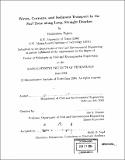| dc.contributor.advisor | Ole S. Madsen. | en_US |
| dc.contributor.author | Tajima, Yoshimitsu, 1972- | en_US |
| dc.contributor.other | Massachusetts Institute of Technology. Dept. of Civil and Environmental Engineering. | en_US |
| dc.date.accessioned | 2005-10-14T20:34:16Z | |
| dc.date.available | 2005-10-14T20:34:16Z | |
| dc.date.copyright | 2004 | en_US |
| dc.date.issued | 2004 | en_US |
| dc.identifier.uri | http://hdl.handle.net/1721.1/29441 | |
| dc.description | Thesis (Ph. D.)--Massachusetts Institute of Technology, Dept. of Civil and Environmental Engineering, 2004. | en_US |
| dc.description | Includes bibliographical references (p. 293-313). | en_US |
| dc.description.abstract | This study presents a theoretical model for predictions of near-shore hydrodynamic characteristics and the local sediment transport rate along long, straight beaches. The wave may be periodic or random, the beach may be plane or barred, and the bed may be concrete or covered with movable natural sand grains. The present model must be efficient and flexible so that it can accommodate iterative computations for time-varying and hence arbitrary beach profiles. The near-shore hydrodynamics model consists of wave, surface roller, and near- shore current models. Both wave and surface roller models are based on simple energy balance equations and, based on these models, the near-shore current is determined from two-layer 2DH momentum equations. Coupled with a simple turbulent eddy viscosity model, vertical profiles of mean shear current are analytically obtained. The model accounts for advective interactions between waves, surface rollers, and currents and, coupled with the surface roller model, explain the shoreward shift of the peak longshore current velocity. The model applies a modified version of Madsen's (1994) wave-current bottom boundary layer model to specify the bottom boundary condition from knowledge of equivalent bottom roughness scaled by a sediment diameter. | en_US |
| dc.description.abstract | (cont.) Introducing the predicted near-shore hydrodynamic characteristics, we extend the conceptual bedload and associated suspended load sediment transport models (Mad- sen, 2001) to the surf zone. The extended sediment transport model accounts for breaking wave effects such as an increase of turbulence due to broken waves and change of the momentum force balances due to breaking waves and surface rollers. The model predicted the peaks of longshore sediment transport observed near the shore line and the wave breaking point for plunging breakers. | en_US |
| dc.description.statementofresponsibility | by Yoshimitsu Tajima. | en_US |
| dc.format.extent | 313 p. | en_US |
| dc.format.extent | 11508303 bytes | |
| dc.format.extent | 11508103 bytes | |
| dc.format.mimetype | application/pdf | |
| dc.format.mimetype | application/pdf | |
| dc.language.iso | eng | en_US |
| dc.publisher | Massachusetts Institute of Technology | en_US |
| dc.rights | M.I.T. theses are protected by copyright. They may be viewed from this source for any purpose, but reproduction or distribution in any format is prohibited without written permission. See provided URL for inquiries about permission. | en_US |
| dc.rights.uri | http://dspace.mit.edu/handle/1721.1/7582 | |
| dc.subject | Civil and Environmental Engineering. | en_US |
| dc.title | Waves, currents, and sediment transport in the surf zone along long, straight beaches | en_US |
| dc.type | Thesis | en_US |
| dc.description.degree | Ph.D. | en_US |
| dc.contributor.department | Massachusetts Institute of Technology. Department of Civil and Environmental Engineering | |
| dc.identifier.oclc | 56193320 | en_US |
